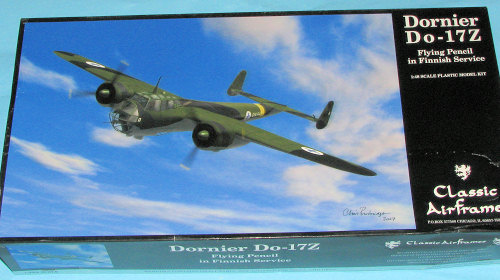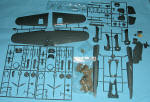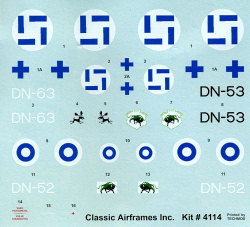
Classic Airframes 1/48 Do-17Z 'Finland'
| KIT: | Classic Airframes 1/48 Do-17Z 'Finland' |
| KIT #: | 4114 |
| PRICE: | $76.95 MSRP, less at GreatModels |
| DECALS: | Three options |
| REVIEWER: | Scott Van Aken |
| NOTES: | Short run with resin parts and injected clear bits |

| HISTORY |
The Do 17 was designed as a Schnellbomber, a light bomber so fast that it could simply outrun defending fighters. In 1932 the Ordnance Department (Heereswaffenamt) issued a specification for the construction of a "freight aircraft for German State Railways", and a "high speed mail plane for Lufthansa". The factory at Friedrichshafen began the design on 1 August 1932.
However, once the Nazis had taken power, in 1933, Hermann Göring became National Commissar for aviation with former Lufthansa employee Erhard Milch as his deputy. In March 1933 the Reichsluftfahrtministerium (RLM - Air Ministry) was established. The Air Ministry was in charge of development and production of aircraft, and soon afterwards the test site at Rechlin became its testing ground.
The Reichsluftfahrtministerium designated the new aircraft Do 17. On 17 March 1933, just three months after taking office, Erhard Milch gave the go-ahead for the building of prototypes. At the end of 1933, orders were made for a 'high speed aircraft with double tail', and for a 'freight aircraft with special equipment', in other words, a bomber. The original design sported a single tail, but in tests it proved to be marginally stable and a new twin-tail version was introduced, which also had the side effect of improving the field of fire for the rear gunner.
In April 1934 the Dornier works at Manzell began project 'definition'. During this month the defensive armament was designed and the bomb release mechanism details ironed out. Military production began on 20 May 1934 and on the 23 November 1934 the Do 17 V-1, powered by two BMW VI7.3 motors took off on its first flight. The tests were positive and more prototypes like the V8 emerged as the forerunner of long-distance reconnaissance, and the V9 which was tested as a high speed airliner Later the Do 17E-1, F-1 and F-2 prototypes appeared. The E-1 was initially powered by two Daimler Benz 600 engines, but were later equipped with Bramo 323 powerplants The modifications proved worthwhile. At the 1937 international air show in Switzerland, the Dornier Do 17 MV 1 proved a leader in its class. It was faster than Allied fighters. It along with the Bf 109, won many prizes demonstrating the prowess of German aviation designs.
It is claimed, unlike the Heinkel He 111 series, whose military use was planned from the start, that the Do 17 was contracted solely as a fast passenger/mailplane to compete with the Heinkel He 70 monoplane, as the Dornier had more internal space. After impressive performances it was surprisingly rejected by Lufthansa as the cramped cockpit space was uncomfortable. Also, the operating costs also were too high for a mailplane.
The purpose for which the Dornier was first designed is uncertain, as many reliable sources disagree. But if the Heinkel He 111 design was acknowledged as a 'wolf in sheeps clothing' and undoubtedly the Luftwaffe was preparing for war, it seems more likely that the Do 17 was a bomber from conception.
The three prototypes remained unused in the Dornier factory in Lowental for almost six months, until, quite by chance Flight Captain Untucht of Lufthansa came across them. After receiving permission to fly one of the machines he proceded to put it through an almost stunt-flying circuit. After landing he said that "the machine is as nimble as a fighter, give it more lateral stability and we'll have a high speed bomber!"
The version of this kit:
| THE KIT |
 Not another Do-17Z kit
review!!
Not another Do-17Z kit
review!!
Well, yes, it is, and one thing I should mention is that I've not only not seen this kit until now, I don't read other websites so am not influenced in any way, shape or form by their opinions, no matter how old the kit is. Besides, it is always a good idea to wait until all the hype is over before looking into things. One of the reasons why MM is more than willing to have kits designed in the 50s and 60s review on these pages. Scale modeling is more than just the newest.
I don't remember if it is Sword or MPM who now makes kits for CA, but it really doesn't matter as both are a known quality. You get a large zip bag in which all the sprues and two other smaller zip bags are located. Since the upper wing is a single piece, it is quite long and managed to tear a significant hole in my bag. From this spilled a number of parts that had worked their way from the trees during shipping as they rubbed and jostled against each other. As the box was not sealed in any way, I'm surprised that nothing seems to have been lost. However, there are quite a few scratches on the surface of various parts. Most will disappear under light sanding and a coat of paint, though some will need filler.
There are four main sprues and all contain well molded parts with nicely done engraved detailing. One sprue is repeated (making five actual parts sprues) and that contains things like props, bombs, engine cowlings, landing gear bits and the like. The engines are especially well done and a single casting (which I like as I hate gluing separate cylinders to a common crankshaft). I should also mention that apparently CA and others have heard how much we all dislike separate prop blades and have cast the propellers as a single mold. Unlike the MPM Roc and Skua recently previewed, these blades are unbroken. The transparency sprue is well molded with well defined frames. They are also relatively clear in that you can see details through them. A dip in Future will probably bring them to full clarity. Those for the lower fuselage and upper wings mount from the inside.
Resin is used for nearly all the interior parts and for
the oil cooler intakes mounted on the engine nacelles. Apparently they forgot to
package a pair as there was a small bag with two of them in with the kit. You
have several options with the kit in that you can pose the bomb bay open (and it
may be the best way to do this as my experience h as
been that a closed bay will require filler and sanding) as well as the crew
boarding ladder.
as
been that a closed bay will require filler and sanding) as well as the crew
boarding ladder.
Instructions are for a general Do-17Z with the markings guide a separate item. I'm sure that we'll be seeing other boxings of this kit with little different other than a decal sheet. The instructions are well done with little detail drawings to show how things are supposed to look. Typical of CA kits, there is a note that one should dry-fit and check part alignment before gluing, a good precaution for any short run kit. The instructions also show the nose (a separate item for when other versions are kitted) to be fitted nearly at the end of the build. This will make it difficult to properly smooth out the join, but on the other hand, it will also make it easier to properly attend to the engine nacelles. A difficult choice for sure.
Markings are for three Finnish AF Do-17Zs. All are in the later olive green/black over light blue scheme with one of them overpainted in spots with white for winter ops. Two options are with the swastika insignia (done in parts, of course) and a third for the late 1944 roundel. These are well printed by Techmod.
| CONCLUSIONS |
I would say that this kit now makes 'all others obsolete' but that is becoming a bit of a trite saying. It is true, though. Unless you tend to shrink back from the MSRP and have the skills to properly build the old Hobbycraft kit, if you want a nice Do-17Z, for the time being, this is it.
| REFERENCES |
http://en.wikipedia.org
November 2007
You can find this and many other fine kits and accessories
at GreatModels
If you would like your product reviewed fairly and quickly, please
contact
me or see other details in the
Note to
Contributors.